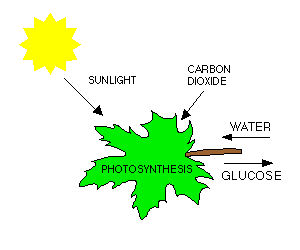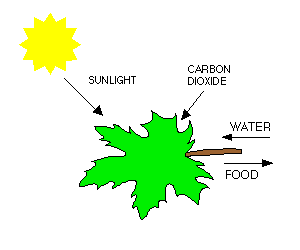We all enjoy the beautiful show of colors as leaves change each autumn. Did you ever wonder how and why this happens? To answer that question, we first have to understand what leaves are and what they do.

Leaves are nature's food factories. Plants take water from the ground through their roots. They take a gas called carbon dioxide from the air. Plants use sunlight to turn water and carbon dioxide into glucose.
Glucose is a kind of sugar. Plants use glucose as food for energy and as a building block for growing.
The way plants turn water and carbon dioxide into glucose is called photosynthesis. That means "putting together with light." A chemical called chlorophyll helps make photosynthesis happen. Chlorophyll is what gives plants their green color.

As summer ends and autumn comes, the days get shorter and shorter. This is how the trees "know" to begin getting ready for winter.
During winter, there is not enough light or water for photosynthesis. The trees will rest, and live off the food they stored during the summer. They begin to shut down their food-making factories. The green chlorophyll disappears from the leaves. As the bright green fades away, we begin to see yellow and orange colors. Small amounts of these colors have been in the leaves all along. We just can't see them in the summer, because they are covered up by the green chlorophyll.
The bright reds and purples we see in leaves are made mostly in the fall. In some trees, like maples, glucose is trapped in the leaves after photosynthesis stops. Sunlight and the cool nights of autumn turn this glucose into a red color. The brown color of trees like oaks is made from wastes left in the leaves.
It is the combination of all these things that make the beautiful colors we enjoy in the fall.
Plants make their own food.
They take water from the ground through their roots. They take a gas called carbon dioxide from the air. They turn water and carbon dioxide into food using sunlight and something called"chlorophyll".
Chlorophyll is green. It gives leaves their green color.

Winter days are short and dry. Many plants stop making food in the fall. The chlorophyll goes away. Then we can see orange and yellow colors. These colors were in the leaves all summer, but the green covered them up.
Some leaves turn red. The red color is made in the fall, from food trapped in the leaves.
Brown colors are also made in the fall. They come from wastes left in the leaves.
WORD SCRAMBLE
How many of these words can you unscramble?
- trawe
- afle
- rnege
- ernago
- mutanu
- loscuge
- gnlituhs
- holoplryclh
Answers follow Projects Section.
All summer, with the long hours of sunlight and a good supply of liquid water, plants are busy making and storing food, and growing. But what about wintertime? The days are much shorter, and water is hard to get. Plants have found many different ways to get through the harsh days of winter.
Some plants, including many garden flowers, are called "annuals," which means they complete their life cycle in one growing season. They die when winter comes, but their seeds remain, ready to sprout again in the spring.
"Perennials" live for more than two years. This category includes trees and shrubs, as well as herbaceous plants with soft, fleshy stems. When winter comes, the woody parts of trees and shrubs can survive the cold. The above ground parts of herbaceous plants (leaves, stalks) will die off, but underground parts (roots, bulbs) will remain alive. In the winter, plants rest and live off stored food until spring.
As plants grow, they shed older leaves and grow new ones. This is important because the leaves become damaged over time by insects, disease and weather. The shedding and replacement continues all the time. In addition, deciduous trees, like maples, oaks and elms, shed all their leaves in the fall in preparation for winter.
"Evergreens" keep most of their leaves during the winter. They have special leaves, resistant to cold and moisture loss. Some, like pine and fir trees, have long thin needles. Others, like holly, have broad leaves with tough, waxy surfaces. On very cold, dry days, these leaves sometimes curl up to reduce their exposed surface. Evergreens may continue to photosynthesize during the winter as long as they get enough water, but the reactions occur more slowly at colder temperatures.
During summer days, leaves make more glucose than the plant needs for energy and growth. The excess is turned into starch and stored until needed. As the daylight gets shorter in the autumn, plants begin to shut down their food production.
Many changes occur in the leaves of deciduous trees before they finally fall from the branch. The leaf has actually been preparing for autumn since it started to grow in the spring.
At the base of each leaf is a special layer of cells called the "abscission" or separation layer. All summer, small tubes which pass through this layer carry water into the leaf, and food back to the tree.
In the fall, the cells of the abscission layer begin to swell and form a cork-like material, reducing and finally cutting off flow between leaf and tree. Glucose and waste products are trapped in the leaf. Without fresh water to renew it, chlorophyll begins to disappear.
Other colors, which have been there all along then become visible. The orange colors come from carotene ('kar-uh-teen) and the yellows from xanthophyll ('zan-thuh-fil). They are common pigments, also found in flowers, and foods like carrots, bananas and egg yolks. We do not know their exact role in leaves, but scientists think they may be involved somehow in photosynthesis.
The bright red and purple colors come from anthocyanin (an-thuh-'si-uh-nuhn) pigments. These are also common in plants; for example, beets, red apples, and purple grapes, and flowers like violets and hyacinths. In the leaves, these pigments are formed in the autumn from trapped glucose.
Brown colors come from tannin, a bitter waste product.
Different combinations of these pigments give us a wide range of colors each fall.
As the bottom cells in the separation layer form a seal between leaf and tree, the cells in the top of the separation layer begin to disintegrate. They form a tear-line, and eventually the leaf is blown away or simply falls from the tree.
One more important question remains. What causes the most spectacular displays?
The best place in the world for viewing fall colors is probably the Eastern United States. This is because of the climate there, and the wide variety of deciduous trees. The brightest colors are seen when late summer is dry, and autumn has bright sunny days and cool (low 40's Fahrenheit) nights. Then trees make a lot of anthocyanin pigments. A fall with cloudy days and warm nights brings drab colors. And an early frost quickly ends the colorful display.
FUN FACTSWhat do autumn leaves and ripening bananas have in common?The green color in unripe bananas comes from chlorophyll, the same pigment that gives green leaves their color. As bananas ripen, the chlorophyll breaks down and disappears, revealing the yellow color which has been there all along. The yellows and oranges of autumn leaves are also revealed as their chlorophyll breaks down. Of course, other changes also occur as banans ripen: the starches change to sugar and the flesh softens as pectin (a carbohydrate) breaks down. |
PROJECTS TO DO TOGETHER
NOTE: ADULT SUPERVISION IS REQUIRED. Please read all instructions completely before starting. Observe all safety precautions.
PROJECT 1 - Separate Colors in a Green Leaf using Chromatography
- - leaves, small jars (baby food jars work well)
- - covers for jars or aluminum foil or plastic wrap
- - rubbing alcohol, paper coffee filters
- - shallow pan, hot tap water, tape, pen
- - plastic knife or spoon, clock or timer.
- Collect 2-3 large leaves from several different trees. Tear or chop the leaves into very small pieces and put them into small jars labeled with the name or location of the tree.
- Add enough rubbing alcohol to each jar to cover the leaves. Using a plastic knife
or spoon, carefully chop and grind the leaves in the alcohol.
SAFETY NOTE: Isopropyl rubbing alcohol can be harmful if mishandled or misused. Read and carefully follow all warnings on the alcohol bottle. - Cover the jars very loosely with lids or plastic wrap or aluminum foil. Place the
jars carefully into a shallow tray containing 1 inch of hot tap water.
SAFETY NOTE: Hot water above 150°F can quickly cause severe burns. Experts recommend setting your water heater thermostat no higher than 125°F. - Keep the jars in the water for at least a half-hour, longer if needed, until the alcohol has become colored (the darker the better). Twirl each jar gently about every five minutes. Replace the hot water if it cools off.
- Cut a long thin strip of coffee filter paper for each of the jars and label it.
- Remove jars from water and uncover. Place a strip of filter paper into each jar so that one end is in the alcohol. Bend the other end over the top of the jar and secure it with tape.
- The alcohol will travel up the paper, bringing the colors with it. After 30-90 minutes (or longer), the colors will travel different distances up the paper as the alcohol evaporates. You should be able to see different shades of green, and possibly some yellow, orange or red, depending on the type of leaf.
- Remove the strips of paper, let them dry and then tape them to a piece of plain paper. Save them for the next project.
PROJECT 2 - Separate Colors in a Fall Leaf using Chromatography
- Repeat step (1)-(8) from Project 1, this time using leaves that have changed color. You may have to wait much longer in steps (4) and (7). There is normally much less of the other colors in the leaves compared to the green chlorophyll.
PROJECT 3 - Observe how light affects color development
- - a tree with leaves that turn red in autumn
- - aluminum foil or heavy paper and masking tape.
- Before the leaves turn colors in the fall, find a maple tree, flowering dogwood, sweet gum, or other tree or shrub that you know will turn bright red or purple.
- Find several leaves that receive bright sunlight, and cover part of them with foil or heavy paper and tape.
- After the leaves have changed color, remove the covering and observe the different colors underneath. These are the colors that were in the leaf all summer. The bright reds and purples are only made in the fall, with exposure to light.